
Neurotransmitters Systems II: GABA & Glycine (Physiology 2)
Neurotransmitters Systems II: GABA & Glycine - Dr Dean Semmens Lecture Outline Welcome to the GABA and Glycine lecture. Inhibitory neurotransmitters are able to prevent the firing of an action potential by hyperpolarising the membrane, thus taking the membrane potential further away from threshold. GABA and glycine are the two major inhibitory neurotransmitters in the CNS. In this lecture you will learn how these neurotransmitters are synthesized, the receptors they act at, and some of the roles that they play in health and disease. Desired Learning Outcomes By the end of this lecture unit, students should be able to: Describe how GABA is synthesised, stored and degraded in the brain Detail the location and signalling pathways of GABA receptors and the consequences of GABA signalling in the brain Describe how glycine is synthesised, stored and degraded in the brain Detail the location and signalling pathways of glycine receptors and the consequences of glycine signalling in the brain Session Resources You can find the full set of PowerPoint slides for the lecture HERE Download HERE. You can find a Kahoot! quiz for the lecture HERELinks to an external site.. Further Reading If you would like to read further or consolidate your knowledge on the topic, I would recommend the following further reading: Neuroscience 5th Edition (Purves) Chapter 6. Neuroscience: Exploring the Brain 3rd or 4th Edition (Bear, Connors, Paradiso) Chapter 6. Any Questions? If you have any questions on the lecture, please feel free to add it to the Padlet discussion board below. Alternatively, please do me email me (dsemmens@sgul.ac.uk) and I'll be very happy to help. I have left some student questions from last year on the Padelt discussion board, just incase this may help with any similar questions that you may have: Made with Padlet Glossary Hyperpolarisation - A change in a cell's membrane potential that takes it further away from 0mV. Glutamate decarboxylase (GAD) – The enzyme that mediates the conversion of glutamate to GABA GABA – a major inhibitory neurotransmitter in the CNS Glycine – another major inhibitory neurotransmitter in the CNS Vesicular inhibitory amino acid transporter (VIAAT) – The transporter responsible for sequestering GABA and glycine into vesicles from the cytosol in the presynaptic bouton GABA reuptake transporter (GAT) – The transporter responsible for sequestering GABA into the presynaptic bouton from the cytosol GABA transaminase – The enzyme that breaks down GABA in the synaptic cleft Panspermia – The theory that the universe contains the materials for the ‘building blocks’ of life Glycine decarboxylase - The enzyme that breaks down Glycine in the synaptic cleft Glycine reuptake transporter (GlyT) - The transporter responsible for sequestering glycine into the presynaptic bouton from the cytosol
-
What is GABA, and what is its primary role in the central nervous system (CNS)? (2)
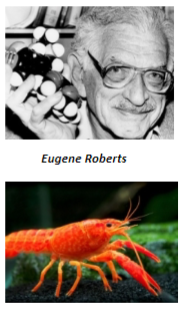
Gamma-aminobutyric acid (GABA) is the major inhibitory neurotransmitter in the CNS.
Its primary role is to prevent excessive neuronal activity and maintain balance in the nervous system.
-
Who discovered GABA in the mammalian nervous system, and when? (1)
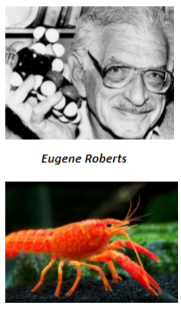
GABA was first identified in the mammalian nervous system by Eugene Roberts in 1950.
-
What significant discovery about GABA was made in 1957? (1)
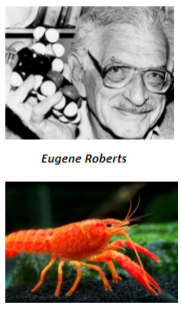
In 1957, GABA was shown to inhibit action potential firing in crayfish neurons.
-
What is the current understanding of GABA's role in the human brain? (2)
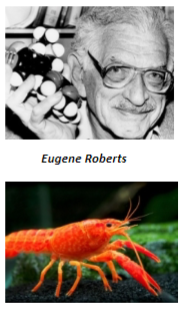
GABA is recognized as the major inhibitory neurotransmitter in the human brain.
Approximately one-third of synapses in the brain utilize GABA as their neurotransmitter.
-
Where is GABA most commonly found as an inhibitory neurotransmitter? (1)
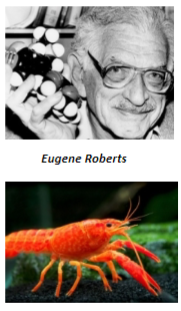
GABA is most commonly found in local circuit interneurons as an inhibitory neurotransmitter.
-
What is the precursor molecule for GABA synthesis? (1)

Glutamate is the precursor molecule for GABA synthesis.
-
What enzyme is responsible for synthesizing GABA from glutamate? (1)

The enzyme responsible for synthesizing GABA from glutamate is Glutamate Decarboxylase (GAD).
-
What co-factor is required for the synthesis of GABA? (1)
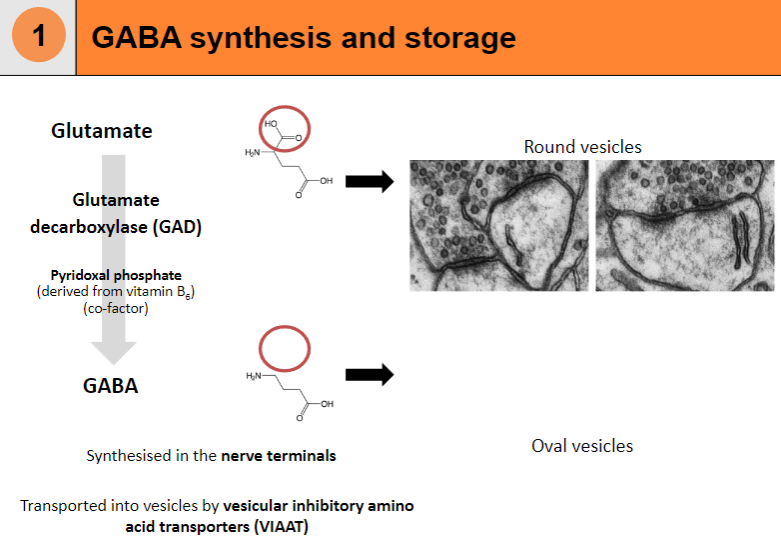
Pyridoxal phosphate, derived from vitamin B6, is required as a co-factor for GABA synthesis.
-
Where is GABA synthesized in the neuron? (1)
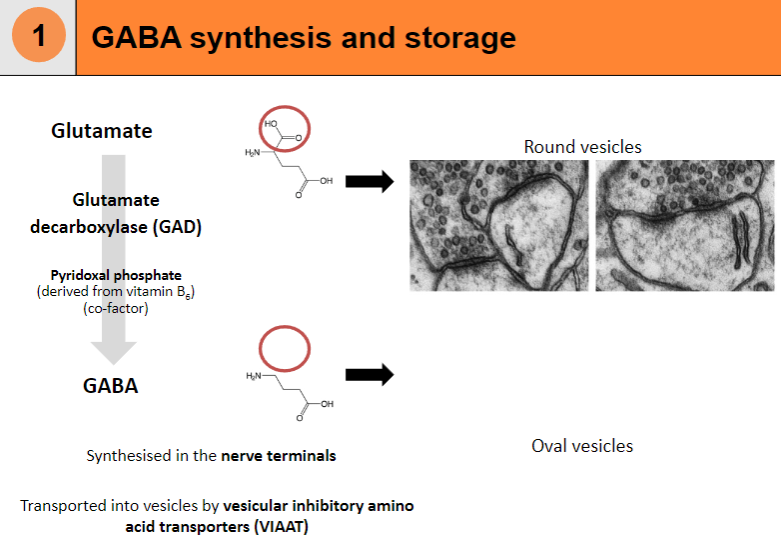
GABA is synthesized in the nerve terminals of neurons.
-
How is GABA stored in the neuron? (1)
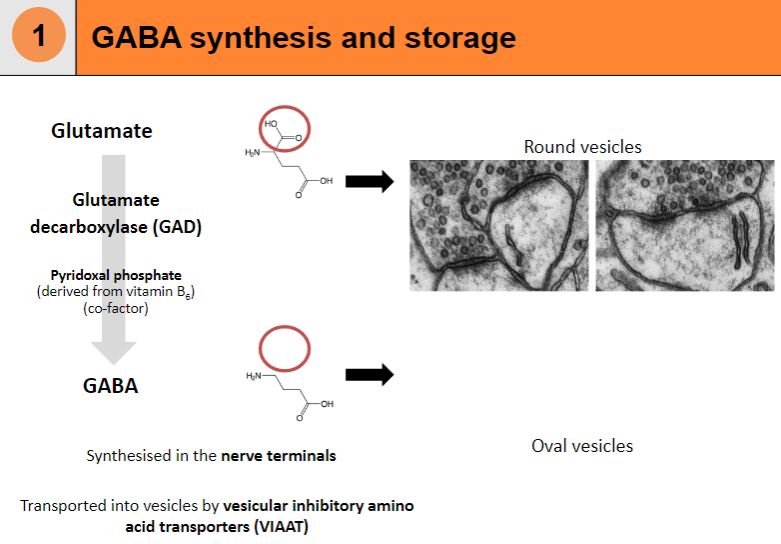
GABA is transported into vesicles by Vesicular Inhibitory Amino Acid Transporters (VIAAT) and stored in round and oval-shaped vesicles.
-
What is the first step in the degradation of GABA? (1)
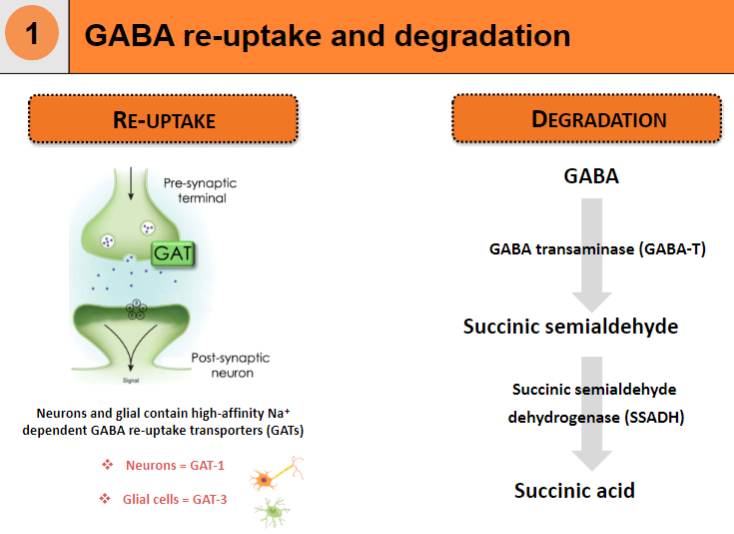
The first step in GABA degradation is the conversion of GABA into Succinic semialdehyde by the enzyme GABA transaminase (GABA-T).
-
What enzyme is responsible for converting Succinic semialdehyde into Succinic acid? (1)
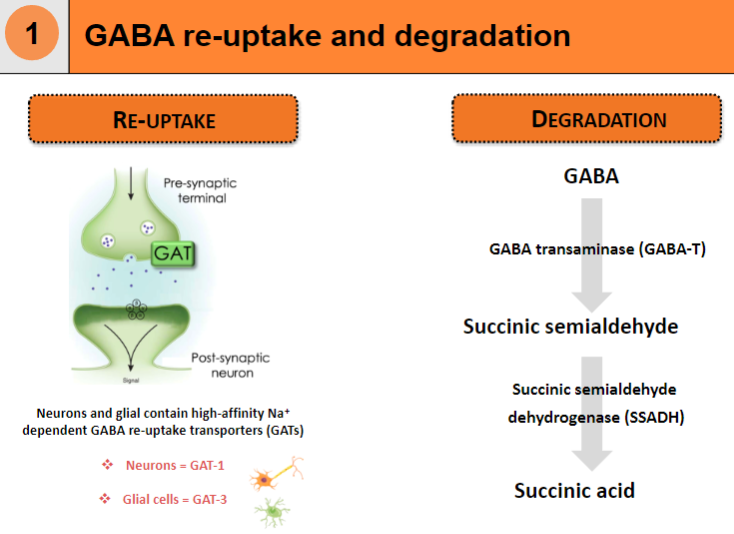
Succinic semialdehyde dehydrogenase (SSADH) is responsible for converting Succinic semialdehyde into Succinic acid.
-
What type of transporters are involved in the re-uptake of GABA? (1)
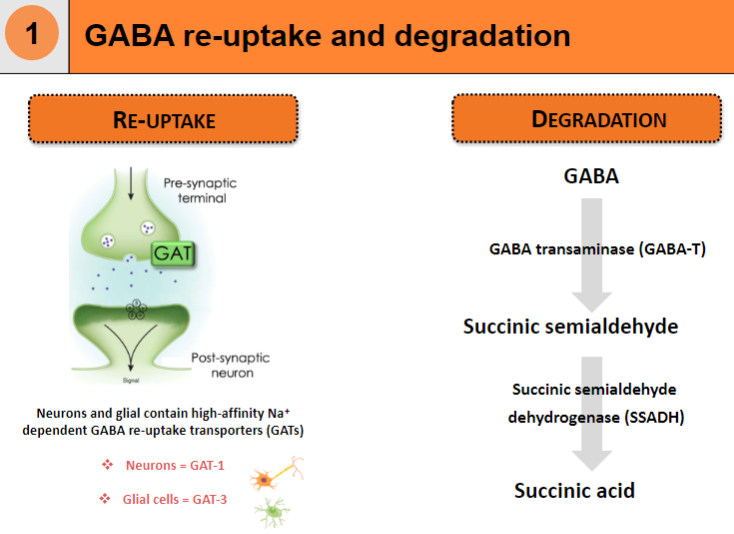
High-affinity Na+ dependent GABA re-uptake transporters (GATs) are involved in the re-uptake of GABA.
-
Which GAT is found in neurons? (1)
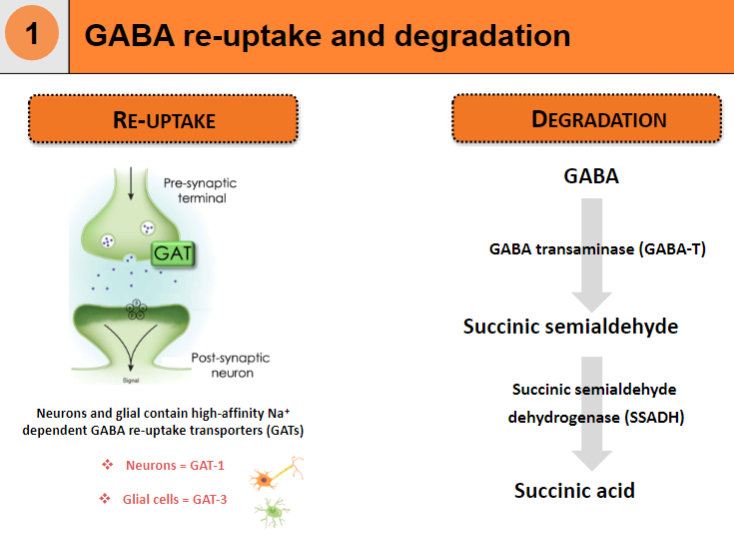
GAT-1 is found in neurons.
-
Which GAT is found in glial cells? (1)
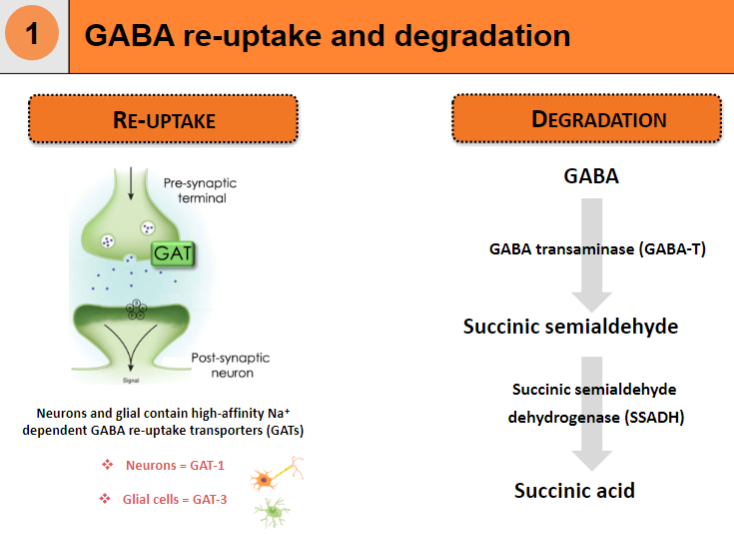
GAT-3 is found in glial cells.
-
A picture demonstrating a summary of GABA synthesis, storage and re-uptake
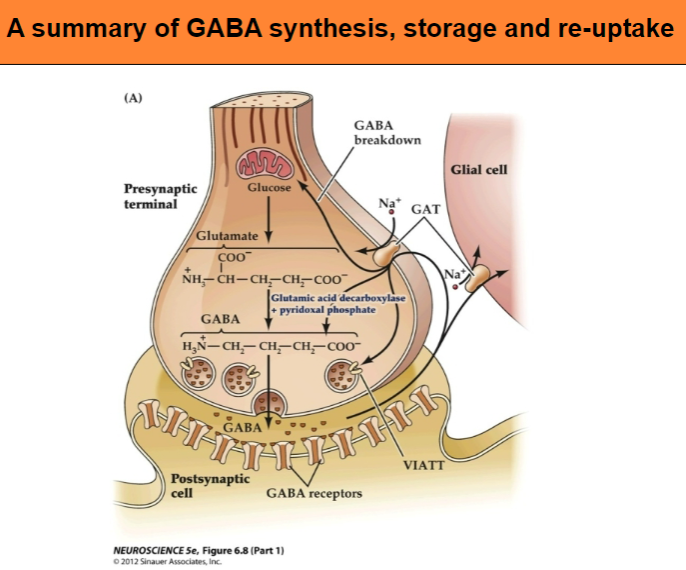
-
What are the two broad families of neurotransmitter receptors? (2)
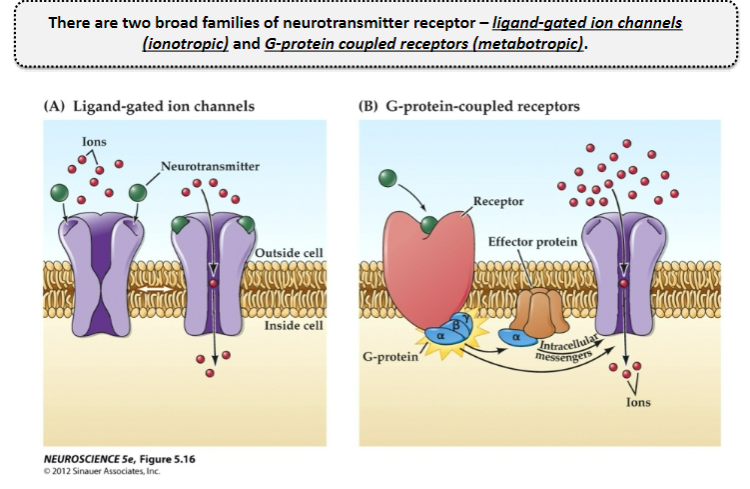
Ligand-gated ion channels (ionotropic)
G-protein coupled receptors (metabotropic)
-
Where does GABA bind in the nervous system? (1)
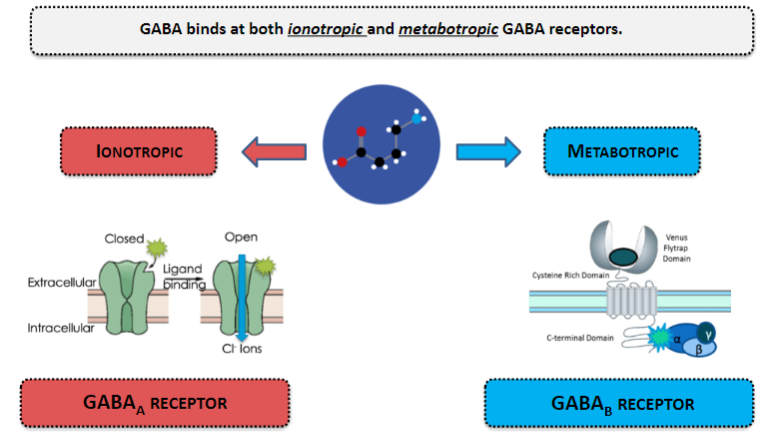
GABA binds at both ionotropic and metabotropic GABA receptors.
-
What is the structure of the GABAA receptor? (2)
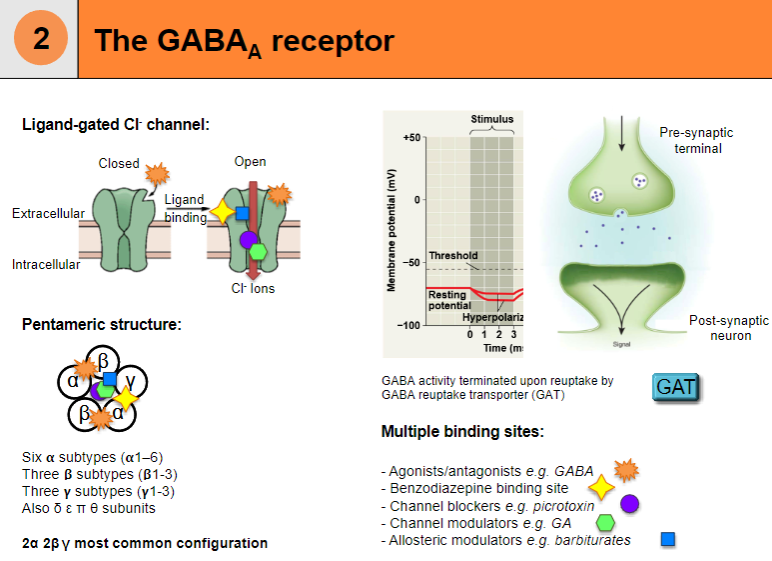
Ligand-gated Cl⁻ channel
Pentameric structure, commonly composed of 2α, 2β, and γ subunits, with other possible subunits (δ, ε, π, θ)
-
What is the function of the GABAA receptor? (1)
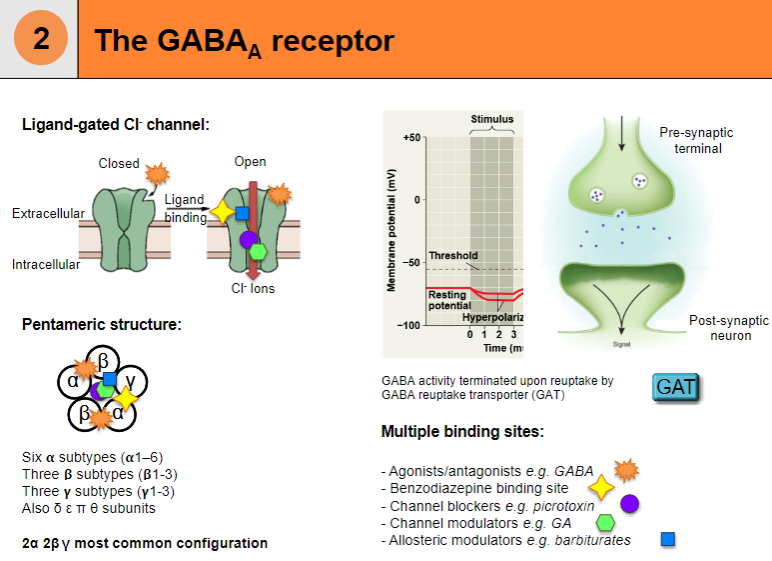
Opens to allow Cl⁻ ions to flow, causing inhibitory postsynaptic potentials (IPSPs) and hyperpolarization of the postsynaptic neuron.
-
What are the modulatory sites on the GABAA receptor? (2)
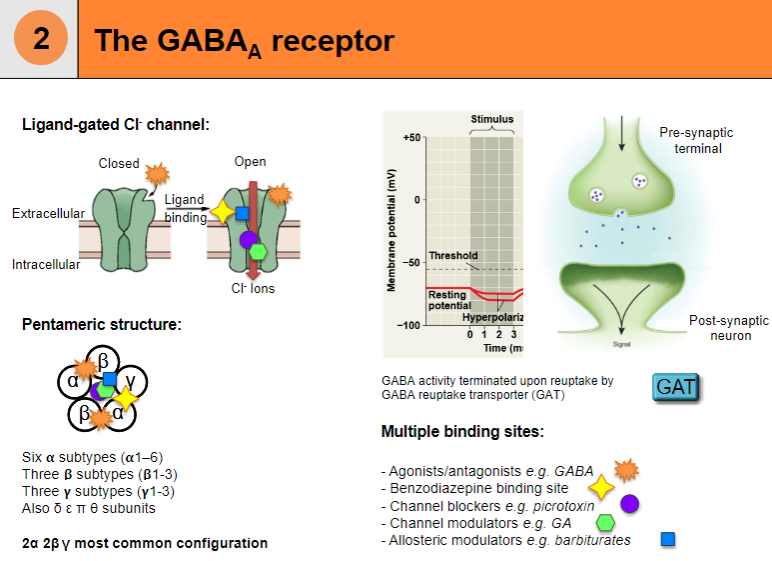
Agonist/antagonist binding site (e.g., GABA)
Additional binding sites for benzodiazepines, channel blockers (e.g., picrotoxin), channel modulators (e.g., GA), and allosteric modulators (e.g., barbiturates)
-
What is the structure and function of the GABAB receptor? (3)
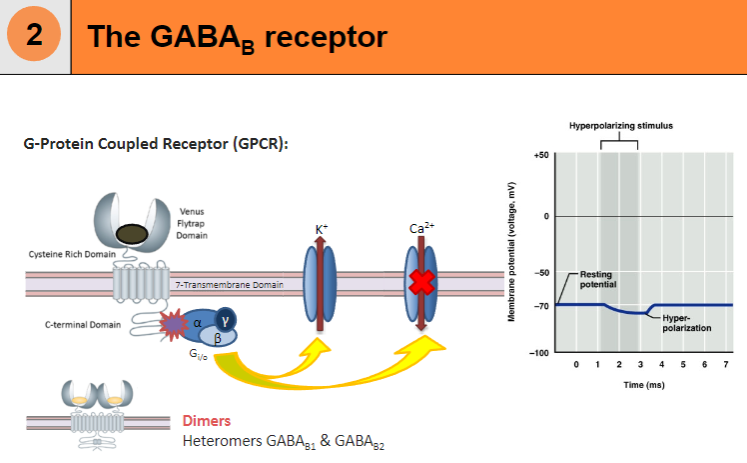
GABA₋B is a G-protein coupled receptor (GPCR) with a 7-transmembrane domain
It functions as a dimer, composed of GABAB1 and GABAB2 subunits
It primarily signals via Gi/o proteins to modulate K⁺ and Ca²⁺ ion channels
-
How do inhibitory neurotransmitters, like GABA, cause hyperpolarization? (2)
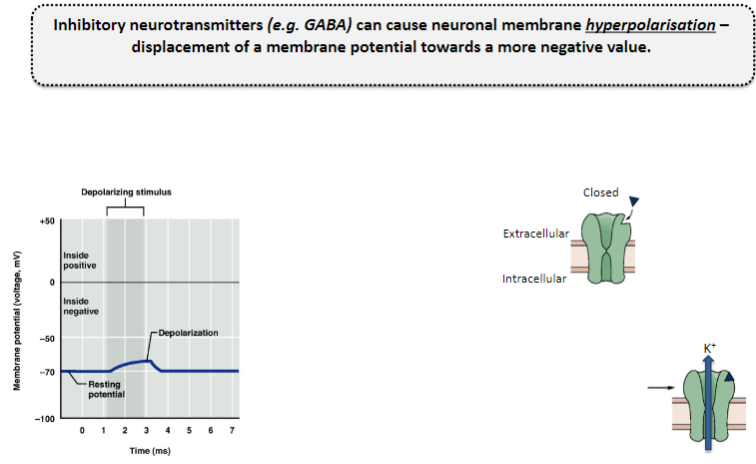
Inhibitory neurotransmitters, such as GABA, bind to receptors and cause the opening of ion channels.
This leads to an influx of Cl⁻ ions or efflux of K⁺ ions, which makes the membrane potential more negative, resulting in hyperpolarization.
-
Picture demonstrating Inhibitory neurotransmitters and hyperpolarisation:
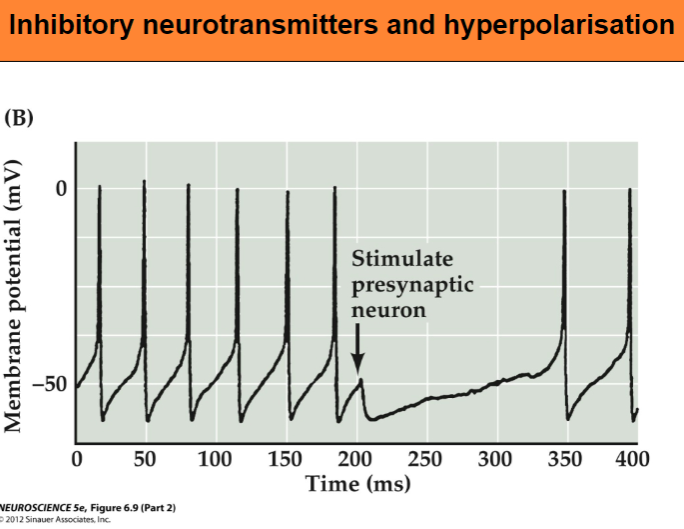
-
What is the cerebellum’s role in movement? (1)
The cerebellum detects differences between the intended movement and the actual movement, helping to correct motor errors.
-
How does the cerebellum contribute to coordinated movement? (1)
The cerebellum works with the motor cortex to produce precise and coordinated movements.
-
What specific function of the cerebellum is important for synchronizing movement with musical rhythm? (1)
The cerebellum is involved in the synchronization of movement with musical rhythm.
-
Is the function of the cerebellum conserved across species? (1)
Yes, the function of the cerebellum is conserved across the animal kingdom.
-
What percentage of the human brain’s volume does the cerebellum account for? (1)
The cerebellum accounts for approximately 10% of the human brain's volume.
-
What is the role of Purkinje cells in the cerebellum? (1)
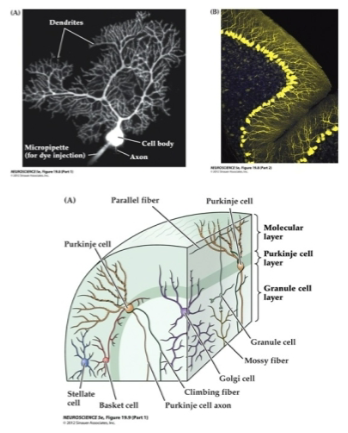
Purkinje cells are GABAergic neurons and the principal projection neurons of the cerebellar cortex.
-
How do Purkinje cells receive input in the cerebellum? (1)
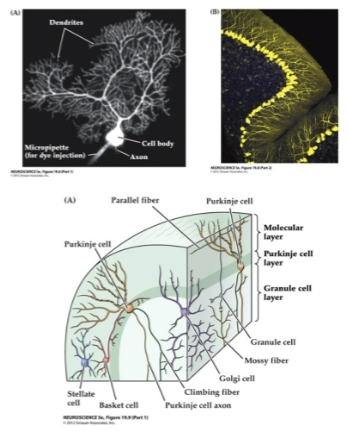
Purkinje cells have elaborate dendritic trees that receive convergent input from cells in the molecular layer.
-
What type of projections do Purkinje cells send and to where? (1)
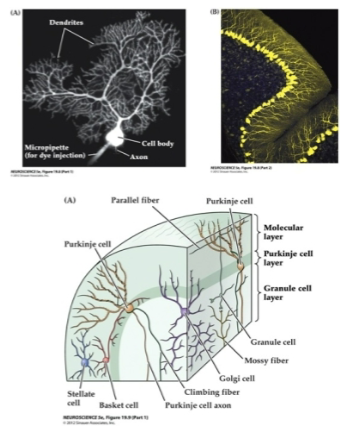
Purkinje cells send GABAergic projections to deep cerebellar neurons.
-
How does the output of Purkinje cells affect movement? (1)
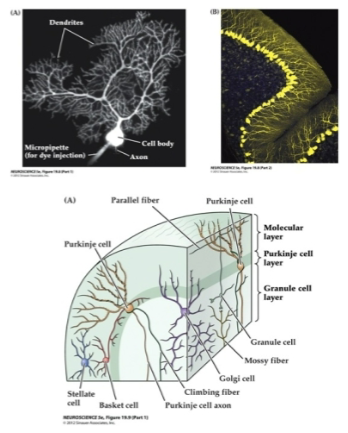
The output of Purkinje cells to deep cerebellar neurons generates an error connection signal that can modify movements.
-
What is the role of Purkinje cells in real-time movement control? (1)
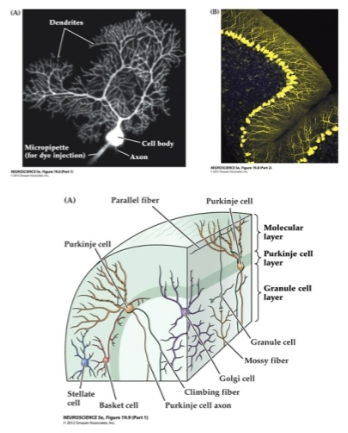
Purkinje cell output provides the basis for the real-time control of precise and synchronous movement.
-
What are the major neurotransmitters involved in controlling the brain's overall level of excitation? (1)
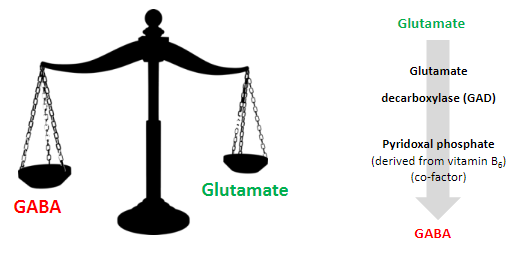
Glutamate and GABA are the major neurotransmitters controlling the brain's overall level of excitation.
-
What happens when the excitatory-inhibitory balance of glutamate and GABA is disrupted? (1)
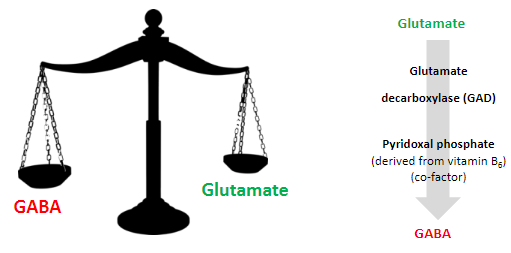
Disruption in the balance of GABA and glutamate can lead to neurological or psychiatric disorders due to altered excitation and inhibition in the brain.
-
How is glutamate converted into GABA in the brain? (1)

Glutamate is converted into GABA by the enzyme glutamate decarboxylase (GAD), with pyridoxal phosphate (derived from vitamin B6) as a co-factor.
-
What is epilepsy and what causes its seizures? (1)
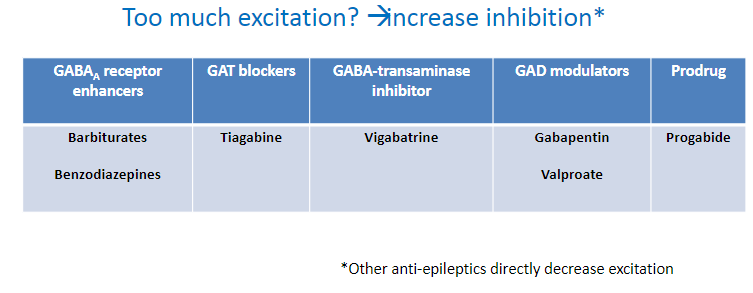
Epilepsy is a brain disorder characterized by periodic and unpredictable seizures caused by the rhythmic firing of large groups of neurons.
-
What is the role of GABA in epilepsy treatment? (1)
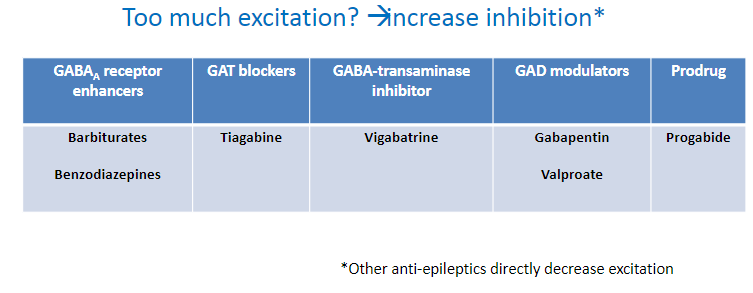
In epilepsy treatment, enhancing GABAergic neurotransmission can help increase inhibition to counteract excessive neuronal excitation.
-
What are some types of drugs that enhance GABAergic neurotransmission in epilepsy treatment? (2)
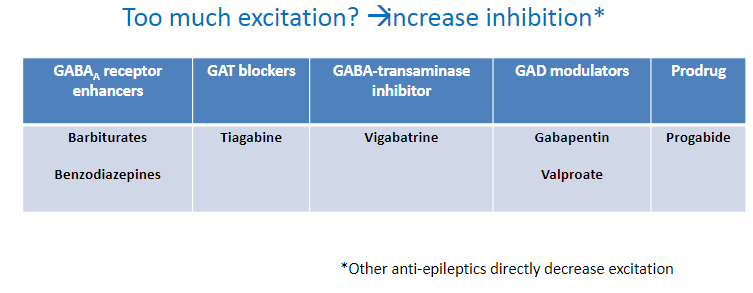
GABAₐ receptor enhancers (e.g., Barbiturates, Benzodiazepines)
GAT blockers (e.g., Tiagabine)
GABA-transaminase inhibitors (e.g., Vigabatrin)
GAD modulators (e.g., Gabapentin, Valproate, Progabide)
-
What is the general approach to treating epilepsy with respect to excitation and inhibition? (1)
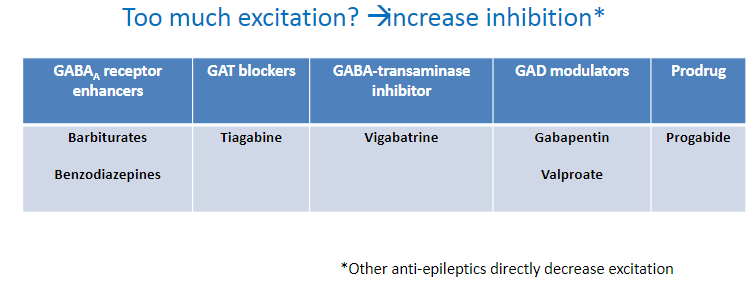
In epilepsy treatment, the general approach is to increase inhibition (through GABAergic agents) to counteract excessive excitation in the brain.
-
What is anxiety and how can it vary in intensity? (1)
Anxiety is a feeling of unease, such as worry or fear, which can range from mild to severe.
-
What are some examples of anxiety disorders? (1)
Generalized anxiety disorder and panic disorder are examples of anxiety disorders.
-
What are anxiolytics and what receptor do they target? (2)
Anxiolytics are medications used to reduce anxiety.
An example of an anxiolytic is benzodiazepines, which target the GABAₐ receptor.
-
What is glycine and what role does it play in the central nervous system (CNS)? (1)
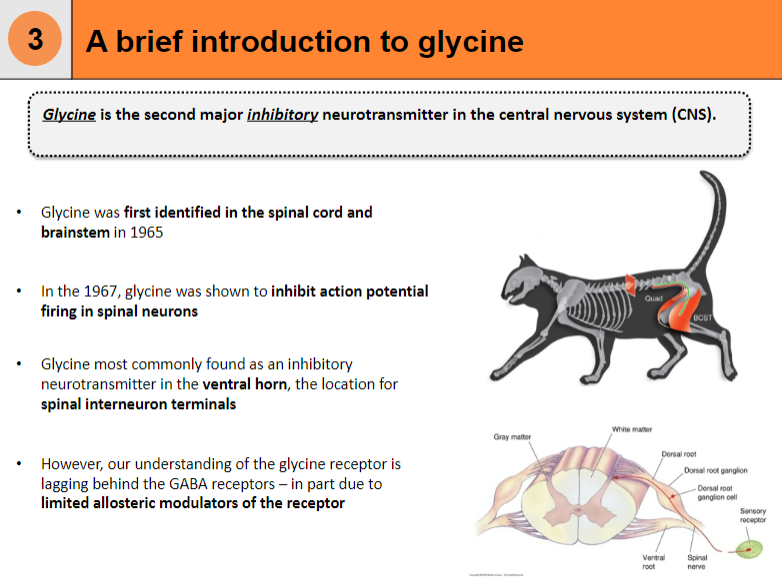
Glycine is the second major inhibitory neurotransmitter in the CNS.
-
When and where was glycine first identified? (2)
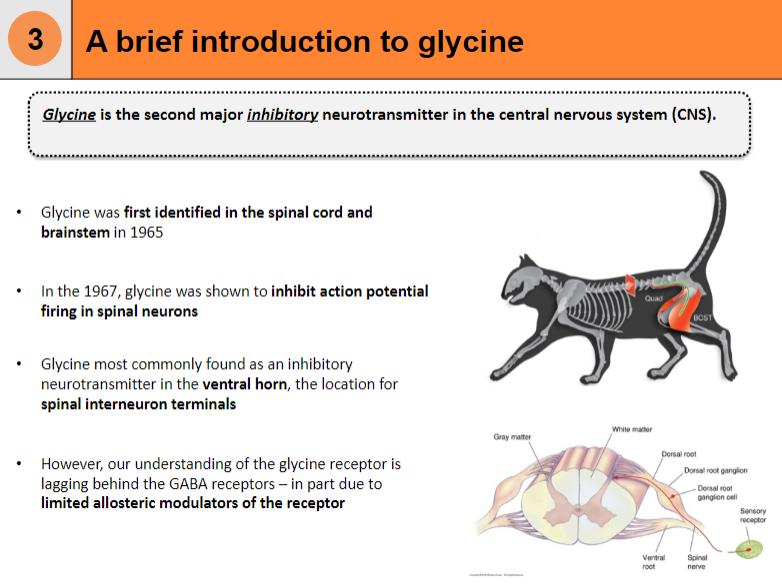
Glycine was first identified in the spinal cord and brainstem in 1965.
In 1967, glycine was shown to inhibit action potential firing in spinal neurons.
-
Where is glycine most commonly found in the spinal cord? (1)

Glycine is most commonly found as an inhibitory neurotransmitter in the ventral horn, where spinal interneuron terminals are located.
-
Why is our understanding of the glycine receptor lagging behind the GABA receptor? (1)
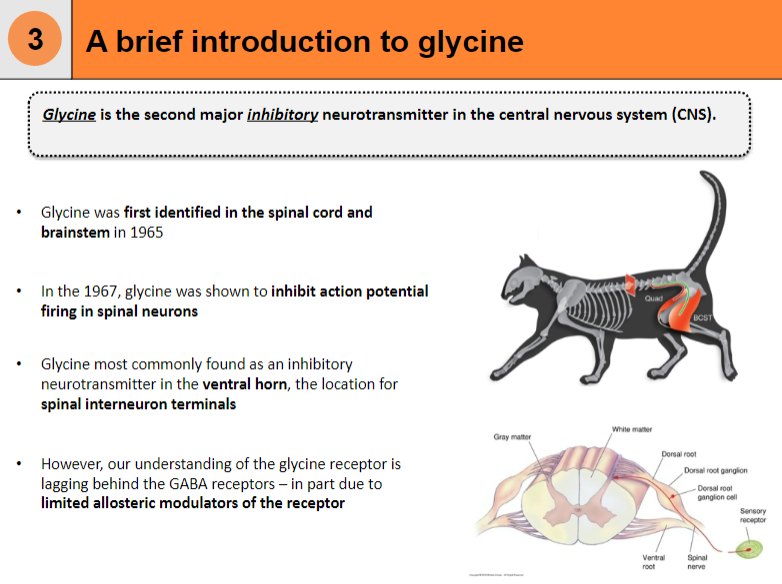
Our understanding of the glycine receptor is behind that of the GABA receptor because there are fewer substances that can modify its function in different ways (known as allosteric modulators).
-
What is the starting compound for glycine synthesis? (1)
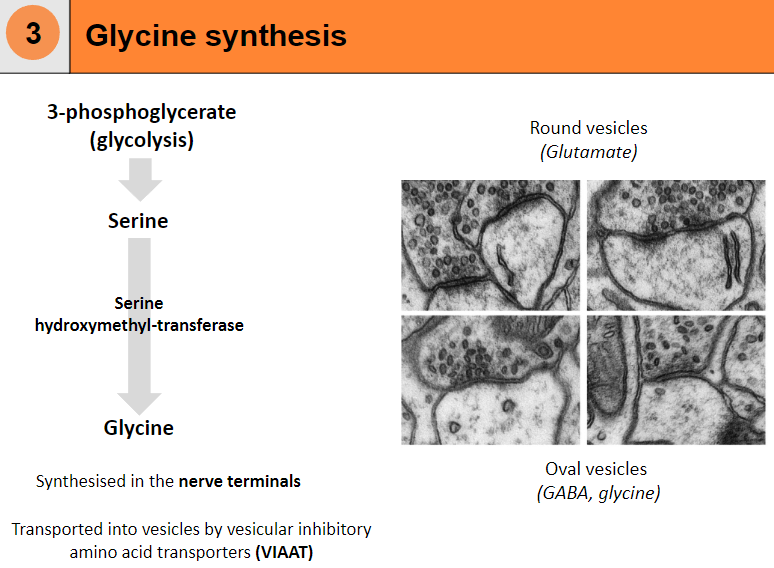
Glycine is synthesized from 3-phosphoglycerate, which is a product of glycolysis.
-
What enzyme is involved in converting serine to glycine during its synthesis? (1)
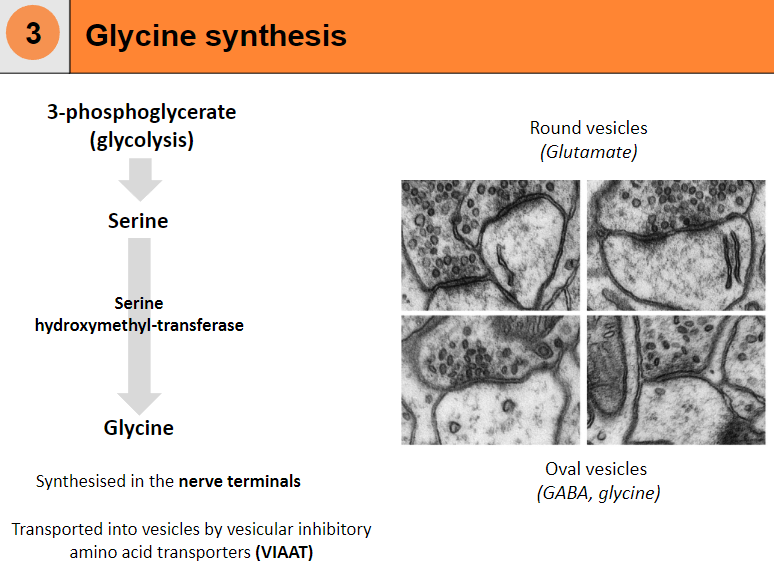
The enzyme serine hydroxymethyl-transferase is responsible for converting serine to glycine.
-
Where is glycine synthesized and how is it stored? (2)
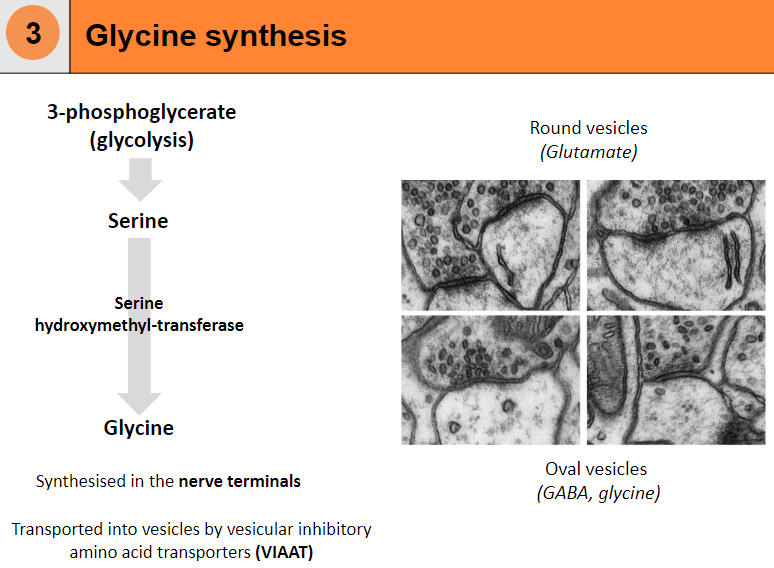
Glycine is synthesized in the nerve terminals.
It is transported into vesicles by vesicular inhibitory amino acid transporters (VIAAT) and stored in oval vesicles.
-
What are the glycine re-uptake transporters and where are they located? (2)
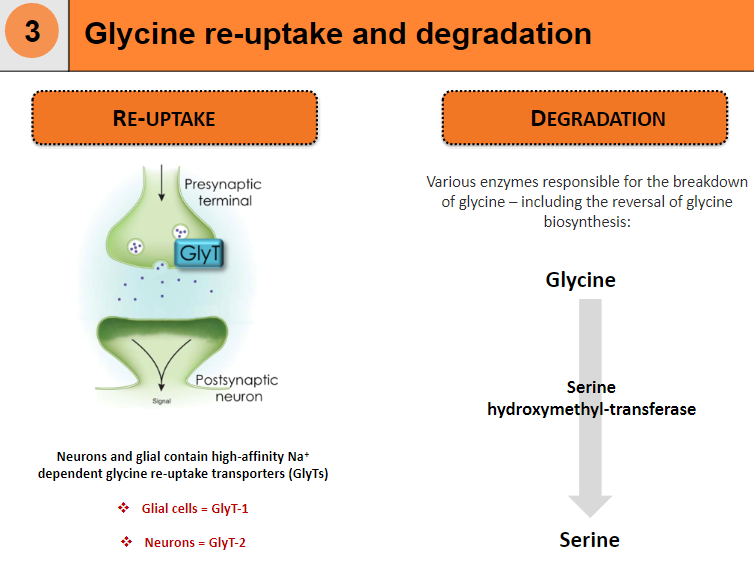
GlyT-1 is found in glial cells.
GlyT-2 is found in neurons.
Both are high-affinity, Na+ dependent transporters responsible for glycine re-uptake.
-
How is glycine degraded? (2)
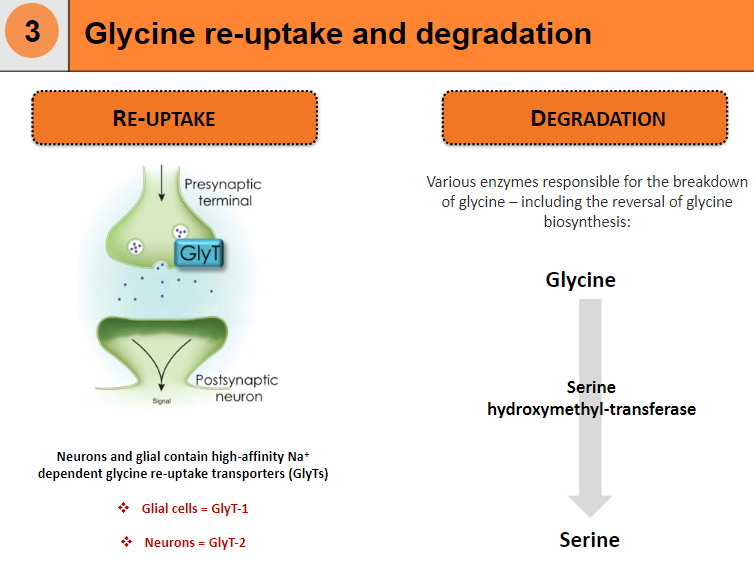
Glycine degradation is carried out by various enzymes.
One key enzyme involved is serine hydroxymethyl-transferase, which is also involved in the reversal of glycine biosynthesis.
-
What is the structure of the glycine receptor and its subtypes? (3)

The glycine receptor is a ligand-gated Cl⁻ channel with a pentameric structure.
It consists of four α subtypes (α1–α4) and one β subtype.
The most common configurations are 3α1β or 4α1β.
-
What are the binding sites and blockers for the glycine receptor? (2)
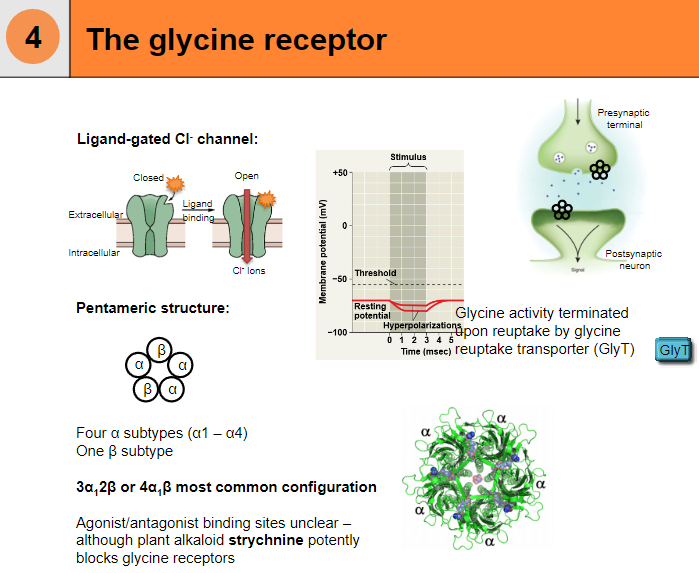
The agonist/antagonist binding sites on the glycine receptor are not fully understood.
Strychnine, a plant alkaloid, potently blocks glycine receptors.
-
How is glycine activity terminated? (1)
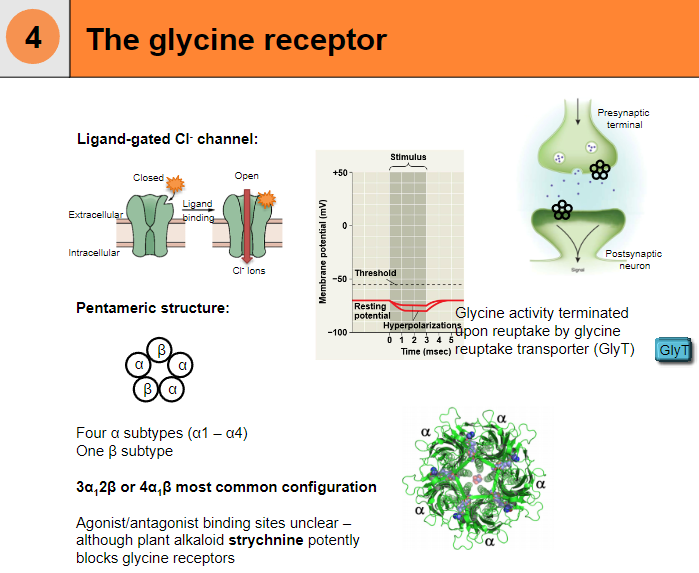
Glycine activity is terminated through reuptake by the glycine reuptake transporter (GlyT).
-
What is hyperekplexia and its main symptoms? (2)
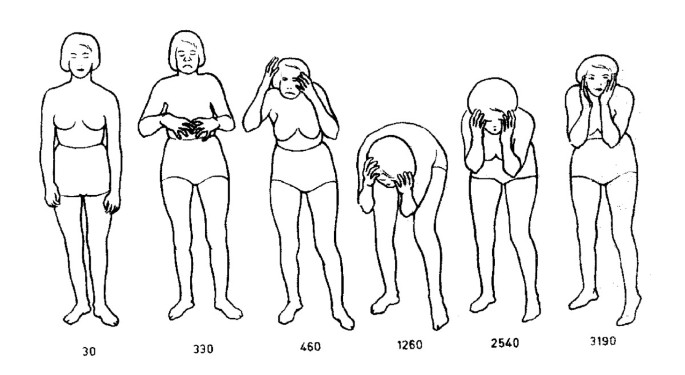
Hyperekplexia is a rare disorder characterized by hypertonia (increased muscle tone) and an exaggerated startle response.
Symptoms can be triggered by unexpected stimuli, such as loud noises.
-
How do gene mutations affect glycine neurotransmission in hyperekplexia? (2)
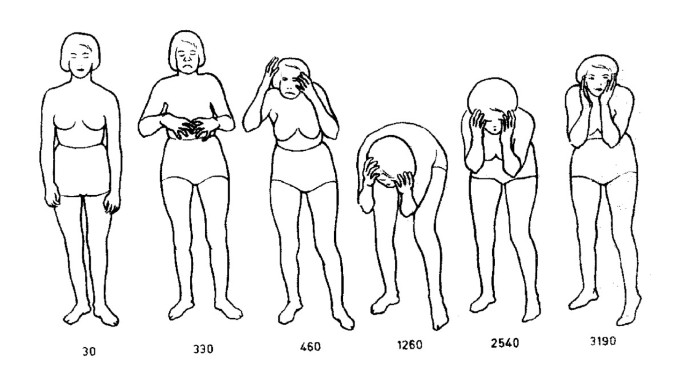
Gene mutations in glycine receptors or glycine transporters can disrupt normal glycinergic neurotransmission.
This disruption can lead to neuronal hyperexcitability by impairing glycinergic inhibition, contributing to the symptoms of hyperekplexia.
-
What is the cause of the startle response in myotonic (fainting) goats? (2)

Decreased muscle chloride conductance is the primary cause of the startle response in myotonic goats.
This decreased conductance can be caused by glycine receptor mutations.
-
How do myotonic goats compensate for glycine receptor mutations? (1)

As the goats mature, GABA receptors are upregulated to compensate for the disrupted glycine receptor function.
-
What is hyperpolarisation? (1)
Hyperpolarisation is a change in a cell's membrane potential that takes it further away from 0mV.
-
What is the role of Glutamate decarboxylase (GAD)? (1)
Glutamate decarboxylase (GAD) is the enzyme that mediates the conversion of glutamate to GABA.
-
What is GABA and what is its role in the CNS? (1)
GABA is a major inhibitory neurotransmitter in the central nervous system (CNS).
-
What is glycine and what is its role in the CNS? (1)
Glycine is another major inhibitory neurotransmitter in the central nervous system (CNS).
-
What is the function of the Vesicular inhibitory amino acid transporter (VIAAT)? (1)
The VIAAT is responsible for sequestering (isolating and storing) GABA and glycine into vesicles from the cytosol in the presynaptic bouton.
-
What is the function of the GABA reuptake transporter (GAT)? (1)
The GABA reuptake transporter (GAT) is responsible for sequestering (isolating and storing) GABA into the presynaptic bouton from the cytosol.
-
What is the role of GABA transaminase? (1)
GABA transaminase is the enzyme that breaks down GABA in the synaptic cleft.
-
What is panspermia? (1)
Panspermia is the theory that the universe contains the materials for the ‘building blocks’ of life.
-
What is the role of Glycine decarboxylase? (1)
Glycine decarboxylase is the enzyme that breaks down glycine in the synaptic cleft.
-
What is the function of the Glycine reuptake transporter (GlyT)? (1)
The Glycine reuptake transporter (GlyT) is responsible for sequestering glycine into the presynaptic bouton from the cytosol.

